Porthcurno
| Porthcurno | |
| Cornwall | |
|---|---|
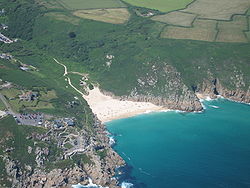 Porthcurno Beach and the Minack Theatre | |
| Location | |
| Grid reference: | SW384223 |
| Location: | 50°2’35"N, 5°39’14"W |
| Data | |
| Post town: | Penzance |
| Postcode: | TR19 |
| Dialling code: | 01736 |
| Local Government | |
| Council: | Cornwall |
| Parliamentary constituency: |
St Just |
Porthcurno is a small village in the parish of St Levan in a valley on the south coast of Cornwall. It is approximately 9 miles west of the market town of Penzance and about 3 miles from Land's End, the most westerly point of the Cornish mainland. Access by road is only available from the north end of the valley along an unclassified spur road off the B3283.
The village has a delightful, quiet, sandy beach sheltered by the high cliffs on either side. Up on the cliffs is found a wonder of Cornwall, the Minack Theatre; an open-air amphitheatre cut into the rock of the cliff which is used for productions each year.
The name "Porthcurno" is from the Cornish language; 'Porth-Curnow' means 'Port (or Bay) of Cornwall'.[1][2] Today there is some evidence of early commercial port activity from the remains of man-made stone tracks for horse-drawn vehicles which may have provided access to the beach, visible on one of the footpaths near the south side of the car park ascending the east side of the valley.
About the village
The village comprises houses and apartment blocks together with a few commercial premises located along the access road known as "The Valley". There is a small sub post office at the north end of The Valley and the road ends at St Levan's Church about half a mile further on from the village. At the southern end of The Valley there is a small hotel, a public car park for about 200 cars, a small seasonal café and a public house.
The village is also accessible on foot by the South West Coast Path, being about two hours' walk from Land's End or about four hours' walk from Penzance for experienced cliff walkers.
Along the coast
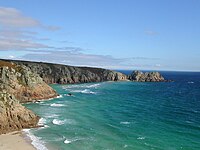
Porthcurno beach and bay enclosed by the Logan Rock headland has been listed among the ten most beautiful bays in the World.[3] The cliffs are enjoyed by walkers using the many public footpaths in the area and the protected South West Coastal Footpath passes through the area often within just a few yards of the clifftops. Coastal areas around Porthcurno, including those formerly owned by Cable and Wireless, are now owned, preserved and maintained by the National Trust and the remainder by the local parish council.
The nearby cliffs rise to 230 feet above mean sea level and are formed from a bedrock of prismatic granite; over the geological timescales having been eroded, shaped and divided vertically and horizontally sometimes almost into rounded cubic blocks.[4][5]
An ancient bridleway, probably an early route to Porthcurno beach by way of the nearby Trendrennen Farm, about half a mile to the east of the village, has been opened by the Ramblers Association. This was probably used by horse-drawn carts to collect seaweed which was used for land fertilisation.
Porthcurno beach and bay, a few hundred yards south of the village is situated in the shelter of the Logan Rock headland just less than a mile to the east. The beach is noted for its sand of crushed, white sea shells, privacy and isolation rather than movement of ships.[1][6][7] Porthcurno Bay has been described as "floored by glorious white sand that shines through translucent water".[8] Sometimes combinations of wind, tides and sea currents can change the 'sandscape' dramatically in a few hours, but the volume of sand is sufficient that it is unusual for the beach to be completely inundated by the sea at high tide. To the immediate east of Porthcurno beach, on the other side of Percella Point is a small tidal beach called Green Bay. Sometimes this is accessible with caution from Porthcurno beach at low tide.
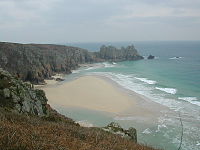
Another tidal beach called Pedn Vounder lies further to the east between Porthcurno and the Logan Rock headland for which footpath access is by a steep and rugged path leading down from the cliff path. Often a sand bank forms off Pedn Vounder at low tide. Unlike the nearby fishing coves of Penberth and Porthgwarra, about one and a half miles to the east and west respectively, Porthcurno has no known recent history of commercial fishing.
The cliffs and coastline around Porthcurno are officially designated Areas of Outstanding Natural Beauty. Part of the Cornwall Area of Outstanding Natural Beauty (AONB) and widely considered as some of the most visually stunning in the United Kingdom.[9][10] Almost a third of Cornwall has AONB designation, with the same status and protection as a National Park.
Minack Theatre
Just out of sight of Porthcurno beach, in the cliff face to the west is the Minack Theatre, a unique open-air theatre with a unique stage backdrop of Porthcurno Bay and the Logan Rock headland. It is an unusual setting for plays staged during the summer months ranging from the traditional Shakespeare to the more contemporary. The theatre is accessible on foot from the coastal footpath by a rugged path in the cliff face or more easily by road taking the steep narrow hill leaving Porthcurno to the south towards St Levan Church and turning left at the top.
The theatre was built virtually single-handedly by the late Rowena Cade who worked there into her eighties with the support of local labourers. Today the Rowena Cade exhibition centre, coffee shop and theatre are open to visitors for most of the year except during performances.
Logan Rock
The Logan Rock headland, about 30 minutes' walk from Porthcurno to the east along the coastal footpath around Porthcurno Bay is famous for the 80 ton granite rocking stone (Logan Rock) perched at the top of the middle outcrop of rocks on the small rocky peninsula. Millennia of erosion had balanced it so finely that one person could move it easily.
In 1824, a group of sailors led by Lieutenant Hugh Calville Goldsmith, nephew of the poet Oliver Goldsmith, and the worse for drink climbed up to Logan Rock armed with crowbars and dislodged it, allowing it to fall down the cliff.[11] Such was the disgust of the local people at this blatant act of vandalism, that they complained to the Admiralty and Goldsmith was ordered to replace the rock at his own expense. It took seven months, 60 labourers and cost Goldsmith £130 8s d at 1824 prices to replace it. The original invoice for equipment and labour is now displayed on the wall of The Logan Rock public house in the nearby village of Treen.
Just to the north of the peninsula is evidence of an Iron Age cliff fort called Treryn Dinas, a scheduled monument comprising about five defensive wall|ramparts, ditches and some evidence of round dwelling huts.[4][12][13][14] There is a small rocky island off the Logan Rock peninsula called Horrace and another smaller granite island called Great Goular which is only visible at low tide.
Porth Chapel Beach
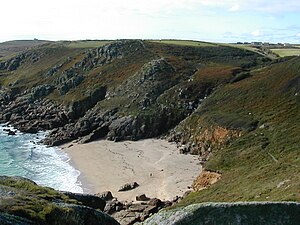
Pedn-men-an-Mere overlooks the small secluded tidal beach of Porth Chapel to the west. Porth Chapel beach is named after the remains of a Christian site[8] and mediæval chapel visible next to the footpath about 30 yards above the beach. There is a spring known as the St. Levan Holy Well further up the cliffside which may be reached by ancient granite steps. The steps were covered for many years but were discovered in 1931 by the Reverend HT Valantine and Dr Vernon Favel. They were restored in 2003.
History
Development of the area was dominated for over one hundred years by the operations of the cable station owned by Cable and Wireless plc and its predecessor companies. Probably over 90% of the inhabitants were either employees of Cable and Wireless or were directly supported by it.
During the Second World War, Porthcurno was designated a Vulnerable Point and was heavily defended and fortified as a part of British anti-invasion preparations. At the beginning of the war a small guard of special constables was put on duty at the cable office and cable house, later superseded by a platoon of soldiers who camped on a former bowling green.[15] Porthcurno valley was declared a protected place and as many as 300 troops were deployed in the immediate area to guard the station.[16] Passes were issued to residents and visitors who had business to be in the area and many mock attacks were staged.[17] The defences included pillboxes and a petroleum warfare beach flame barrage[18] which could be operated remotely from the tunnel.[16] At the end of the War, although some 867 bombs fell in the (Penzance) area and 3957 houses were damaged or destroyed, the only damage suffered by any communications equipment at Porthcurno was the destruction of an antenna when a bomb fell at Rospletha Farm, located at the top of the hill about half a mile to the west of the cable office.[15]
Much of the beach and surrounding shores previously owned by Cable and Wireless was donated to the National Trust in 1993 in common with many other parts of the Cornish coastline.[7]
Most of the houses along the valley were owned by the former Cable and Wireless Engineering College and sold off subsequent to its closure in 1993. Many of them have been converted to holiday flats making the population very seasonally dependent. Today the major industry in the area is tourism.
International telegraphs
The Cable Station and Engineering College
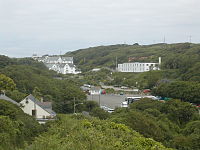
Porthcurno is unusually well known for its size because of its history as a major international submarine communications cable station. In the late nineteenth century, the remote beach at Porthcurno became internationally famous as the British termination of early submarine telegraph cables, the first of which was landed in 1870, part of an early international link stretching all the way from Britain to India.[19] Porthcurno was chosen in preference to Falmouth because of the reduced risk of damage to the cables caused by ships' anchors in the busy port.[19][20] In 1872, the Eastern Telegraph Company (ETC) Limited was formed which took over the operation of the cables and built a cable office in Porthcurno valley.
ETC and its cable operations expanded through the late nineteenth and early twentieth centuries, in 1928 to merge with Marconi's Wireless Telegraph Company Limited to form Imperial and International Communications Limited which was renamed Cable and Wireless Limited in 1934.[21] Cable and Wireless Limited was a predecessor company of Cable & Wireless Worldwide.
In the Interwar period, the Porthcurno cable office operated as many as 14 cables simultaneously, for a time becoming the largest submarine cable station in the world, with the capacity to receive and transmit up to two million words a day.
The cable office closed in 1970, exactly 100 years after the first cable was landed, but the college remained open, receiving substantial investment in buildings and training equipment through the 1970s and 1980s, but this also closed permanently in 1993.
Second World War tunnels
The cable office at Porthcurno was a critical communications centre and considered at serious risk of attack during the Second World War being only about 100 miles from the port of Brest in occupied France.[22][15] To improve security a network of two parallel tunnels, connected by two smaller cross-tunnels, was bored into the granite valley east side by local tin mining labourers, starting in June 1940, to accommodate the essential telegraph equipment.[23] Each of the two main entrances was protected by offset and double bomb-proof, gas-proof doors. To provide evacuation for staff in case the defences failed, a covert emergency escape route was provided by granite steps cut into a steeply rising fifth tunnel leading from the rear cross tunnel to a concealed exit in the fields above.[23] Each of the main tunnel interiors was that of a windowless open-plan office constructed as a building shell within the granite void, complete with a pitched roof to collect water seepage from the rocks, a false ceiling, plastered and decorated walls and all the necessary services.
In total about 15,000 tons of rock were removed to construct the tunnels. The construction work progressed relentlessly day and night, taking nearly a year and the completed tunnels were opened in May 1941 by Lady Wilshaw who was the wife of Sir Edward Wilshaw, Chairman of Cable and Wireless at the time.[24][25] The concrete defences around the tunnel entrances and the nearby buildings were camouflaged with the help of a local artist, the design, when viewed from the air with some imagination, resembling a belt of trees, complete with rabbits and birds.[26] The Tunnel environment being secure, dry, and at a virtually constant temperature proved to be ideal for the sensitive telegraph equipment and it continued to house the subsequently upgraded equipment after the War until the cable office closure in 1970. It was then used for training facilities for the Engineering College until the college itself also closed in 1993. Today the tunnel is both an exhibit itself and houses exhibits of the Porthcurno Telegraph Museum, operated by PK Trust, a charity formed by Cable and Wireless Limited.[27][28]
Submarine optical fibre cables
Porthcurno's association with international telecommunications links continues to the present day. The first successors to submarine telegraph cables were submarine telephony cables of coaxial construction, some of which were landed at Porthcurno. In the last twenty years or so these have all been superseded by their very high-capacity modern descendants, those using fibre optic technology as the transmission medium instead of copper. These also have been landed at Porthcurno forming a significant link, part of the United Kingdom connection to the international telecommunications 'backbone' infrastructure. These form parts of international cable networks of which each has thousands of times the capacity of all of their predecessors' cables put together. However, all of the successors of the telegraph cables today use Porthcurno merely as a shore landing-point for connecting to the national telecommunications network, passing directly via landlines buried under the local roads to a terminating station at Skewjack about 2 miles inland from Porthcurno.
Wireless Point
A small headland to the west of the Minack Theatre called Pedn-men-an-Mere, which is now owned by The National Trust, is known locally as 'Wireless Point'. Here, exposed areas of granite bedrock and concrete plinths retain the preserved remains of the base and guy wire tether points of a wireless telegraphy antenna mast that was erected in 1902 by the Eastern Telegraph Company.[29][30] It was thought that this was used to 'spy' on the early wireless transmissions by Marconi, a developer of radio, from the Poldhu cliff top about 17 miles to the east, across Mount's Bay on the west side of the Lizard. In those days Marconi's 'wireless telegraphy' was seen as a potential threat to the established 'cable and line telegraphy' on which the security of Porthcurno and many jobs depended. A small hut was built nearby to house the early wireless equipment and remained there for a further 21 years.[29] The company mistakenly concluded that Marconi's efforts posed no threat to their cable business. Marconi's secretive development of the Shortwave Beam Wireless System at Poldhu would be so successful that Eastern and many other cable telegraph companies were forced into near-bankruptcy by 1928.
Outside links
| ("Wikimedia Commons" has material about Porthcurno) |
- Wire around the World Porthcurno to Alice Springs by Telegraph, BBC Radio 4
- St. Levan Holy Well restoration project
- Cornwall Record Office Online Catalogue for Porthcurno
References
- ↑ 1.0 1.1 Andrews; p 506
- ↑ McArthur; p 244
- ↑ St. Levan Parish Plan (2006), Introduction
- ↑ 4.0 4.1 Knowlden; p 8
- ↑ Transactions of the Royal Geological Society of Cornwall, Vol. 17 (1950)
- ↑ Long; p 184
- ↑ 7.0 7.1 Andrews; p 24
- ↑ 8.0 8.1 Rainsley; p 147
- ↑ (August 2010)
- ↑ Knowlden; pp 8–9
- ↑ Godwin; p 45
- ↑ St. Levan Parish Plan (2006); p 8
- ↑ Chapman; p 21
- ↑ Andrews; p 25
- ↑ 15.0 15.1 15.2 Bell; p 6
- ↑ 16.0 16.1 Bell; p 7
- ↑ Bell; p 17
- ↑ Foot, 2006, pp 81–87
- ↑ 19.0 19.1 Godwin; p 67
- ↑ Hart-Davis; p 102
- ↑ Godwin p 75
- ↑ Foot
- ↑ 23.0 23.1 Godwin; pp 76–77
- ↑ Bell; p 1, p 29
- ↑ Bell; p 5
- ↑ Bell; p 12
- ↑ Godwin; p 79
- ↑ (August 2010)
- ↑ 29.0 29.1 Godwin; p 72
- ↑ Information from the plaque fixed to the concrete plinth.
Books and general references
- Foot, William (2006). Beaches, fields, streets, and hills ... the anti-invasion landscapes of England, 1940. Council for British Archaeology. ISBN 1-902771-53-2.
- Godwin, Mary; Weeks, Alison (co-ordinator) (2004). Porthcurno Telegraph Station, The Book of St. Levan: Crabs, Crousts and Clerks (Chapter 5); St. Levan Local History Group. Halsgrove, Halsgrove House, Tiverton, Devon EX16 6SS. ISBN 1-84114-328-6.
- Hart-Davis, Adam (2001). What the Victorians Did for Us. Headline Book Publishing, London. ISBN 0-7553-1137-X.
- Ordnance Survey Landranger Map Sheet 203, 1:50,000 scale, Edition D1; Land's End and the Isles of Scilly. Ordnance Survey, Romsey Road, Southampton SO16 4GU, United Kingdom. 2010. ISBN 978-0-319-48029-8.
- Andrews, Robert (2004). Rough Guide to England. Rough Guides Limited, The Penguin Group. ISBN 1-84353-249-2.
- Bell, W. F. A. (1945, 2005 (re-print)). Porthcurno in Wartime. Porthcurno Telegraph Museum, The PK Trust, Porthcurno TR19 6JX, United Kingdom. ISBN 1-905419-01-5.
- Cutler, Thomas J. (2002). The Bluejacket's Manual,United States Department of the Navy. ISBN 1-55750-221-8.
- King, Christine et. al. (2005). BTEC First Diploma in Travel and Tourism. ISBN 0-435-45947-3.
- Long, Peter (2003). The Hidden Places in Cornwall. Travel Publishing Limited. ISBN 1-902007-86-7.
- Rainsley, Mark (2008). South West Sea Kayaking. Pesda Press. ISBN 978-1-906095-05-5.
- Ordnance Survey OS Explorer Map, 1:25,000 scale; Sheet 102 Land's End. Ordnance Survey, Romsey Road, Southampton SO16 4GU, United Kingdom. 2010. ISBN 978-1-84676-155-3 (1846761557).
- Viccars, Sue (2010). Cornwall Day by Day. John Wiley & Sons Limited. ISBN 978-0-470-72100-1.
- McArthur, Tom; McArthur, Roshan (1998). The Oxford Concise Companion to the English Language. Oxford University Press. ISBN 978-0-19-280061-9.
- Chapman, Sarah (2008). Iconic Cornwall. Alison Hodge, Penzance.
- Andrews, Robert (2009). Top Ten: Devon and Cornwall, Eyewitness Travel. Dorling Kindersley Limited. ISBN 978-1-4053-3767-0.
- Knowlden, Martin (2005). 50 Walks for Birdwatchers. AA Publishing, Basingstoke, UK.
- St. Levan Parish Plan 2006. St. Levan Parish Council. February 2006.
- Hardy, Stephen (September 1997). Gemini Submarine Link Steps Closer to Completion. Lightwave, Pennwell Corporation, 98 Spit Brook Road, Nashua NH03062, USA.
- FLAG Network Expanded. Lightwave (op. cit.). December 1995.
- 10 Gbps WDM Transmission with Optical Add/Drop Multiplexing over RIOJA Submarine Cable System. Submarine Fiber Optic Newsletter, Submarine Fiber Optic Communications Systems, Vol. 3, No. 6 (Alcatel). June 1995.
- House, D. J. (2000). The Command Companion for Seamanship Techniques, Vol. 3. Butterworth - Heinemann, Oxford OX2 8DP, UK. ISBN 0-7506-4443-5.
- High Capacity Undersea Cable Goes Live. Electronics Weekly, Reed Business Information Limited, Sutton, Surrey SM2 5AS. May 1998.
- Allen, Thomas B. (December 2001). The Future is Calling. National Geographic Magazine, 1145, 17th. Street NW, Washington DC 20036-4688.
- Fedden, Robin; Joekes, Rosemary (1977). The National Trust Guide. National Trust (Great Britain).
- Transactions of The Royal Geological Society of Cornwall, Vol. 17. 1950.
